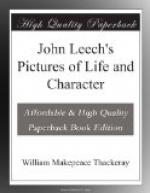By William Makepeace Thackeray
* Reprinted from the Quarterly Review, No. 191, Dec. 1854, by permission of Mr. John Murray.
We, who can recall the consulship of Plancus, and quite respectable, old-fogyfied times, remember amongst other amusements which we had as children the pictures at which we were permitted to look. There was Boydell’s Shakspeare, black and ghastly gallery of murky Opies, glum Northcotes, straddling Fuselis! there were Lear, Oberon, Hamlet, with starting muscles, rolling eyeballs, and long pointing quivering fingers; there was little Prince Arthur (Northcote) crying, in white satin, and bidding good Hubert not put out his eyes; there was Hubert crying; there was little Rutland being run through the poor little body by bloody Clifford; there was Cardinal Beaufort (Reynolds) gnashing his teeth, and grinning and howling demoniacally on his death-bed (a picture frightful to the present day); there was Lady Hamilton (Romney) waving a torch, and dancing before a black background,—a melancholy museum indeed. Smirke’s delightful “Seven Ages” only fitfully relieved its general gloom. We did not like to inspect it unless the elders were present, and plenty of lights and company were in the room.
Cheerful relatives used to treat us to Miss Linwood’s. Let the children of the present generation thank their stars that tragedy is put out of their way. Miss Linwood’s was worsted-work. Your grandmother or grandaunts took you there and said the pictures were admirable. You saw “the Woodman” in worsted, with his axe and dog, trampling through the snow; the snow bitter cold to look at, the woodman’s pipe wonderful: a gloomy piece, that made you shudder. There were large dingy pictures of woollen martyrs, and scowling warriors with limbs strongly knitted; there was especially, at the end of a black passage, a den of lions, that would frighten any boy not born in Africa, or Exeter ’Change, and accustomed to them.
Another exhibition used to be West’s Gallery, where the pleasing figures of Lazarus in his grave-clothes, and Death on the pale horse, used to impress us children. The tombs of Westminster Abbey, the vaults at St. Paul’s, the men in armor at the Tower, frowning ferociously out of their helmets, and wielding their dreadful swords; that superhuman Queen Elizabeth at the end of the room, a livid sovereign with glass eyes, a ruff, and a dirty satin petticoat, riding a horse covered with steel: who does not remember these sights in London in the consulship of Plancus? and the wax-work in Fleet Street, not like that of Madame Tussaud’s, whose chamber of death is gay and brilliant; but a nice old gloomy wax-work, full of murderers; and as a chief attraction, the Dead Baby and the Princess Charlotte lying in state?




